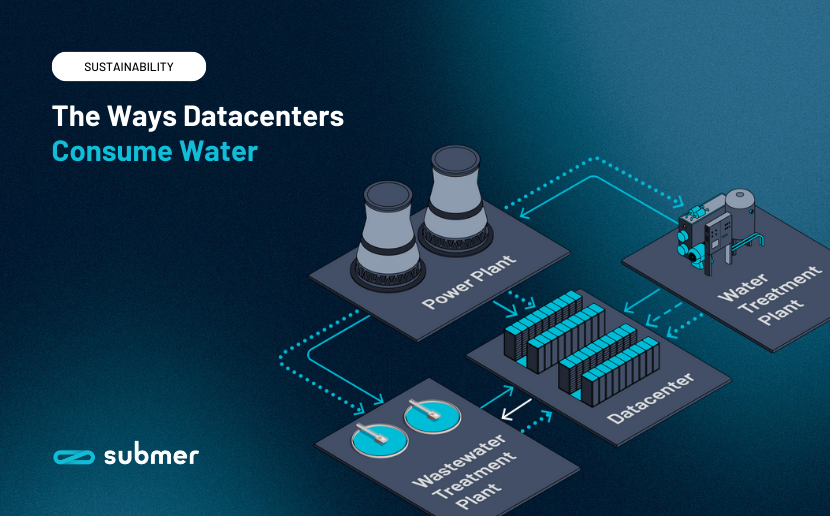Water scarcity is a pressing global issue that affects almost half of the world’s population; projections have even indicated a 40% shortfall in freshwater resources by 2023. In recognition of this crisis, the United Nations declared the International Decade for Action “Water for Sustainable Development” in March 2018 to mobilize efforts for better water management. As a result of this increased awareness and passionate activism, water usage has become a critical sustainable Key Performance Indicator (KPI) for companies worldwide.
Datacenters have long been under scrutiny for their significant energy consumption and now, in light of global water scarcity concerns, calls for transparency and more conscious use ring truer than ever. In this blog post, we’ll specify how datacenters consume water, and explore some of the initiatives aimed at reducing water footprints.
The Ways in Which Datacenters Consume Water
Aside from the water footprint of building datacenters and the material purchased, the water used to run a datacenter can be split into the following 2 main areas:
1. Direct Consumption
Making up approximately 25% of DC water consumption, this is the amount of water consumed directly by the data center to function. Aside from some facility use and humidification, nearly all of this consumption comes down to cooling.
This figure can be reduced by increasing temperatures, implementing an energy-efficient cooling system, and switching to liquid cooling e.g., immersion cooling or direct-to-chip cooling.
2. Indirect Consumption
Depending on the datacenter’s location and energy mix, indirect water consumption can represent up to 75% of its total water consumption in a year.
To arrive at this figure, we need to look beyond the datacenter itself and consider all the systems connected to it. Of course, a data centre needs electricity. In the illustration below, where the lines indicate the flow of resources, we can see that electricity is typically provided by a power plant.

Consuming water and rejecting wasted water requires water treatment before consumption and after wastewater rejection. This also implies using more water to treat the wasted water. Reducing the amount of water used for cooling directly impacts the amount of water required for treatment and disposal.
Logically, the more electricity is produced for the datacenter by the power plant, the more water is used, and the more emissions are produced. Therefore, the water footprint of a datacenter is the sum of this entire system which works to keep it in operation.
In order to reduce the amount of water used from the grid, it is necessary to:
- Maximize IT efficiency: Maximize the MWh/Energy consumed by taking into consideration hardware refresh, power management enablement, virtualization, automated workload placement, DC management systems, and the like.
- Maximize cooling efficiency: By reducing the energy consumption of cooling systems, not only will direct water consumption be decreased, but also its indirect water consumption will be reduced by lowering its energy use.
- Switch to renewable energy: Renewables such as geothermal, wind, and solar provide significant reductions in water usage.

Who’s Keeping an Eye on This?
On a more positive note, governments are making moves to monitor and reduce global emissions:
- EU Taxonomy Regulation: The EU Taxonomy Regulation is implemented through delegated acts that specify the technical screening criteria to address the six environmental objectives: climate mitigation, climate adaptation, water, circular economy, pollution prevention, and biodiversity.
- European Energy Efficiency Directive (EED): The EED is a code of conduct for energy efficiency in datacenters and promotes the use of low-energy-intensity water sources for cooling and humidity control.
- Legislation in North Virginia: Proposed legislation in North Virginia aims to regulate data center developments, monitor carbon footprints, and assess water usage impact.
In addition to legislation, many standards and frameworks have been established or are being put in place to measure and reduce datacenter water usage, such as the Global Reporting Initiative (GRI), Ecovadis, ASHRAE standards, ISO guidelines, and Cooling Efficiency Ratios (CER).
Datacenter Water Usage: First Steps to Making Savings
At Submer, with our knowledge of data centres from the inside out, we’ve witnessed the incredible impact immersion cooling is capable of. Leveraging this technology to increase your energy efficiency and reduce your direct water consumption and wastewater treatment can make a huge difference, not just for your organization but for the planet.
If you’re interested in seeing the water savings your datacenter could experience with our immersion cooling, give us a shout today!



